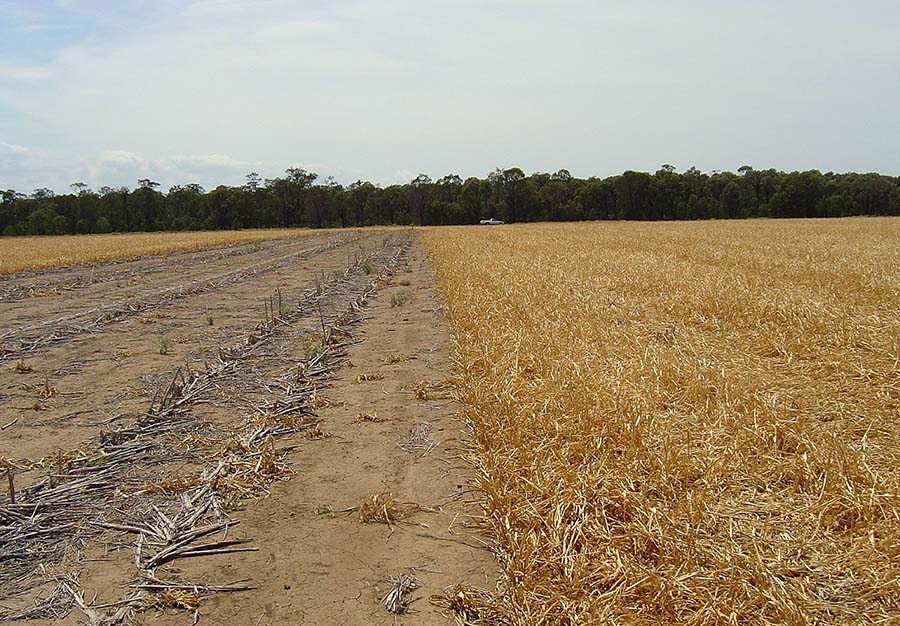Crop paddocks with no stubble can result in poor rain capture during the fallow period.
Storm rains this past summer (2018-19) and autumn (2019) commonly saw extensive water runoff, soil erosion and poor water storage for the next crop. This poor fallow water capture has contributed to poorer crop performance.
Research results presented to the recent 2019 Australian Agronomy conference found that growing a summer cover crop, such as millet, is worth considering to provide ground cover able to improve fallow rainfall capture.
While the cover crop uses water for its growth, provided there is summer and autumn rainfall after it is desiccated, the net benefit can be increased summer/autumn water capture and better water extraction in the following crop.
“Growing a summer cover crop, such as millet, is worth considering to provide ground cover able to improve fallow rainfall capture.”
This ongoing research is being conducted at Bungunya, 70 kilometres west of Goondiwindi, by the Queensland Department of Agriculture and Fisheries (DAF), CSIRO and independent soil scientist David Freebairn. GRDC and the Cotton Research and Development Corporation co-fund the research.
Long-fallow paddock study
The study was established in a long-fallow paddock following skip-row sorghum harvested in February 2017.

A trial comparing fallow versus millet stubble as part of cover crop research in the northern region. Photo: Lawrence Price
It had deep phosphorus applied in August 2017 and was 'Kelly-chained' in September 2017, leaving it with little cover. Cover crops were sown on 11 October 2017.
Three cover crop termination dates were used with millet:
- early at first node (dry matter 1.5 tonnes per hectare);
- mid at flag leaf emergence
- late at anthesis (4.7t/ha).
Sorghum, lablab and a mixed species treatment were sprayed out at the same time as the mid-terminated millet. Wheat was sown across all treatments on 1 May 2018.
Key rainfall totals included:
- 86 millimetres between planting of cover crops to mid-termination;
- 205mm in 11 events from mid-termination to planting of a wheat crop (not atypical for much of the northern grain belt); and
- 41mm from wheat sowing to maturity (three events).
Cover crops recover water
All cover crop treatments, except lablab, had recovered the water they used prior to termination, with some accumulating more plant available water (PAW) than the long fallow control.
Apart from added soil water storage, additional ground cover from cover crops improved wheat establishment compared to bare long fallow in this drier-than-average season. Delaying millet termination provided more ground cover, with it persisting longer.
Late-spray-out millet and sorghum collapsed across the inter-row after spray-out, increasing ground cover later in the fallow period.
Between mid-termination and 28 February 2018, 175mm of rain fell in 10 events and millet treatments all recovered the PAW they had used.
Late-terminated, rolled millet
Late-terminated and rolled millet had 19mm more PAW than the control. When wheat was planted on 1 May, the mid-terminated millet had 13mm more PAW than the long fallow control. Late-terminated millet had 15mm more and late millet rolled had 31mm more.
Water extraction by the wheat was greater from all millet cover crops.
Wheat following millet and sorghum cover crops yielded $200 to $400 per hectare more than for the bare long fallow.
Wheat on long fallow yielded 1.45t/ha, but after early removed millet, wheat yielded 2.2t/ha. After medium-stage millet desiccation, wheat yielded 2.4t/ha and after late removal 2.9t/ha.
Yield differences explained
Soil water differences at the end of fallow probably explain some of the yield difference.
Cover crops had more water in the zero to 10-centimetre layer, which is likely to have improved wheat establishment.
Expected yield increases from the higher fallow water storage alone would typically be about 15 kilograms/ha/mm of stored soil water and account for yield increases of 0.2 to 0.54t/ha grain.
However, the measured yield gains for these treatments were 0.95 to 1.46t/ha.
Benefits from spraying-out
Cover crops had more water in the zero to 10-centimetre layer, which is likely to have improved wheat establishment.
These results confirm that a crop can be grown and sprayed out to improve ground cover in a long fallow, without having a net negative effect on PAW, and with yield benefits in the following crop exceeding what can be explained solely by increased soil water.
This research is ongoing and requires careful interpretation for relating to other New South Wales and Queensland environments.
Proceedings of the 2019 Agronomy Australia Conference, Wagga Wagga, are available at www.agronomyaustralia.org/conference.
More information: Andrew Erbacher, DAF, andrew.erbacher@daf.qld.gov.au

























































